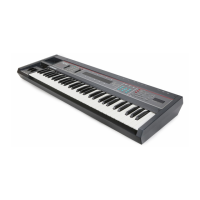SQ-80 — Musician's Manual
UNDERSTANDING THE ENVELOPES
n Envelope is a shape, or "contour" that we apply to some signal source to make it change through time.
Naturally occurring sounds have their own Envelopes. They don't just start and stop — they might start
loud and fade to silence, or slowly swell from silence to a huge crescendo; they might start out very brigh
and grow duller; they might have subtle variations in pitch, and so on.
In a synthesizer we imitate these effects, and create wholely new ones, by generating Envelopes and then
using them to modulate pitch. volume, brightness, etc. The SQ-80 has four Envelopes
hich can be
independently assigned as modulation sources to the various OSC's, DCA's, LFO's, PAN and the
FILTER.
The ADSR Connection
Let's start by taking a look at the commonly used ADSR (Attack, Decay, Sustain, Release) type
Envelopes found on many synthesizers. With the ADSR Envelope, the name says it all. You have four
parameters to control:
Attack — The Time it takes to go from zero, when a key is struck, to peak level
Decay — The Time it takes to go from the peak level to the Sustain Level
Sustain — The Level at which the signal remains as long as the key is held down
Release — The Time it takes to return to zero after the key is released
ADSR Envelope
Notice that an Envelope is really just a series of Levels that change through Time. With the four
parameters of the ADSR Envelope, we can control three Times (Attack, Decay and Release) and one
Level (Sustain). This is fine for many basic volume and brightness Envelopes, but for more complex
sounds — for subtle pitch Envelopes and other cool effects — it becomes necessary to have more specific
control over more Times and Levels. Which brings us back to the SQ-80.
Times and Levels
The four Envelopes on the SQ-80 are defined in terms of Time and Level. For each Envelope, you have
control over four Time segments (TIME 1, TIME 2, TIME 3, and TIME 4) and three Levels (LEVEL
1, LEVEL 2
and LEVEL 3),
hen a key is struck the Envelope level, starting at Zero, takes a fixed amount of time defined by TIME 1
to reach LEVEL 1. It then takes TIME 2 to reach LEVEL 2. Next. at the end of TIME 3 it reaches
LEVEL 3, where it will remain as long as the key is held down. After the key is released the signal takes
TIME 4 to return to Zero (unless the value of TIME 4
s followed by an "R." in which case a Second
Release Time will follow TIME 4. See below).
ec
on
o
ce
ro
ramm
n
5

